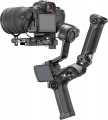Max. load
The maximum weight that the stabiliser is designed to carry.
This is the maximum weight of the camera with all accessories allowed for this model.
Tilt angle
The range of forward-backwards tilt angles relative to the vertical position supported by the stabiliser.
It can be written in different ways.
The simplest option is when one angle value is indicated in the characteristics. This may mean that the camera can deviate from the neutral position in both directions by the same angle, which is half the range.
Another option is used when the angles of tilt forward and backward are not the same. In such cases, the horizontal position of the camera on a vertical steadicam is taken as zero, the “-” sign indicates the maximum angle of camera deflection back, lens up, and the “+” sign — forward, lens down.
Bank angle
The range of roll angles (to the side) supported by the stabiliser.
Can be recorded in two ways (See "Tilt angle")
Max. controlled speed
The maximum controlled speed supported by the stabiliser is, in fact, the highest speed of rotation of the camera along one axis or another, provided by the device. This is the maximum rotation speed of the entire structure, at which the stabiliser automation can provide effective stabilisation along the corresponding axis (that is, keep the camera stationary).
This item is directly related to the purpose of the stabiliser — for shooting while hiking or cycling on flat terrain, a high stabilization speed is hardly necessary, but during surfing, acrobatic aerobatics and other similar activities, the “slow” stabiliser often turns out to be ineffective.
Battery model
Model of the battery used in the stabiliser. This information is not very important when choosing: if you wish, knowing the battery model, you can find detailed information about it. However, the key characteristics of the battery are usually given in general information about the stabiliser. Nevertheless, model information can be useful if you plan to purchase an additional battery, or if you already have a battery and you need to evaluate its compatibility with the device.
Capacity
The capacity of the battery used in the stabiliser.
In theory, a higher capacity allows you to work longer without recharging, but the battery life of the stabiliser also depends on its power consumption. So, only models with similar performance characteristics can be compared with each other according to this indicator; and when choosing, it is better to focus not on the capacity, but on the directly claimed battery life.
Battery life
The maximum length of time the device will work before it needs its battery to be recharged. It is worth considering that the manufacturer indicates the maximum time, which does not correspond to real indicators due to the conditions and intensity of use.
Shooting modes
—
Time lapse. Shooting video in time lapse mode involves a very low frame rate (one frame every few seconds, or even minutes). In the completed video, the effect of fast movement is achieved (for example, the day from sunrise to sunset fits in just a few minutes). However, this is the general principle of time lapse; but the specific ways of its implementation may be different depending on the specific model of the stabiliser.
-
Selfie mode. A separate mode for shooting selfies. This function can be implemented in different ways, depending on the purpose of the device. It is aimed at filming himself and the immediate environment of the operator.
-
Sports mode. The mode is designed for high-quality shooting of dynamic scenes in motion. In sports mode, the stabiliser automatically compensates for frame deviations from the reference location, while the motor runs at the highest possible speed.
-
Panorama. In this shooting mode, the camera attached to the device automatically rotates around its axis, taking a series of shots, from which the panoramic image is then “glued together”. Most often, this function involves the creation of horizontal panoramas. However, camera movement in the vertical plane can also be provided.
—
Tracking mode. Automatic tracking of a
...certain object by pointing the camera so that the shooting target is constantly in the centre of the image, or at least in the frame. The subject for tracking is set by the stabiliser operator.
— Inversion mode. This mode allows you to turn the device upside down, retaining all its functions and camera position. It will come in handy when shooting from atypical angles (for example, from the ground).Folding
Foldable stabilisers can be neatly folded to a compact size, which is very convenient for storage and safe transportation. Both the handle and the mount of the stabiliser itself can be folded. But it is worth paying attention to the fact that such a design solution makes the stabiliser more vulnerable to mechanical impacts because over time the telescopic mechanism and swivel joints will begin to wear out.

